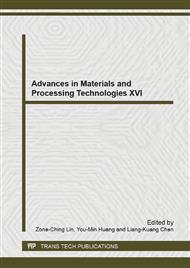[1]
A. Giostri, M. Binotti, P. Silva, E. Macchi, G. Manzolini, Comparison Of Two Linear Collectors In Solar Thermal Plants: Parabolic Trough Vs Fresnel, Proceedings of the ASME 2011 5th International Conference on Energy Sustainability, ES2011, August 7-10, 2011, Washington, DC, USA.
DOI: 10.1115/es2011-54312
Google Scholar
[2]
D. Feuermann, J. M. Gordon, M. Huleihil, Solar Fiber-Optic Mini-Dish Concentrators: First Experimental Results And Field Experience, Sol. Eng. Vol. 72, No. 6, p.459–472, (2002).
DOI: 10.1016/s0038-092x(02)00025-7
Google Scholar
[3]
M. Kaltschmitt, W. Streicher, A. Wiese, Renewable Energy: Technology, Economics and Environment, fourth ed., Springer, New York, (2001).
Google Scholar
[4]
M. Landoa, J. Kagana, B. Linyekina, V. Dobrusin, A solar-pumped Nd: YAG laser in the high collection efficiency regime, Opt. Comm. 222 (2003) 371–381.
DOI: 10.1016/s0030-4018(03)01601-8
Google Scholar
[5]
R. Pereira, D. Liang, High conversion efficiency solar laser pumping by a light-guide/2D-CPC cavity, Opt. Comm. 282 (2009) 1385–1392.
DOI: 10.1016/j.optcom.2008.12.052
Google Scholar
[6]
M. Lando, Y. Shimony, R. M.J. Benmair , D. Abramovich, V. Krupkin, A. Yogev, Visible Solar-Pumped Lasers, Opt. Mat. 13 (1999) 111-115.
DOI: 10.1016/s0925-3467(99)00019-1
Google Scholar
[7]
J. Ruelas, N. Velázquez, J. Cerezo, A Mathematical Model To Develop A Scheffler-Type Solar Concentrator Coupled With A Stirling Engine, Appl Energy, (2012).
DOI: 10.1016/j.apenergy.2012.05.040
Google Scholar
[8]
C. Chena, C. Lina, H. Janb, A Solar Concentrator With Two Reflection Mirrors Designed By Using A Ray Tracing Method, Optik 121 (2010) 1042–1051.
DOI: 10.1016/j.ijleo.2008.12.010
Google Scholar
[9]
V. Badescu, Computing global and diffuse solar hourly irradiation on clear sky, Review and testing of 54 models, Volume 16, Issue 3, April 2012, Pages 1636–1656.
DOI: 10.1016/j.rser.2011.12.010
Google Scholar
[10]
I. Ali and K. Reddy, Optical Performance Of Circular And Elliptical 3-D Static Solar Concentrators, National Solar Conference, American Solar Energy Society 2010, Arizona, USA.
Google Scholar
[11]
http: /uae2. gsfc. nasa. gov/uae_solar_elevation_angles. pdf.
Google Scholar


